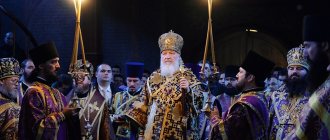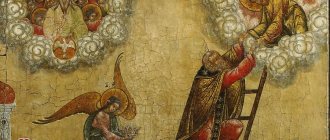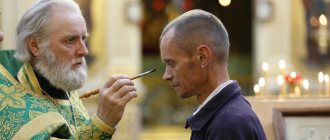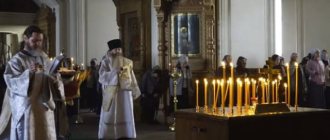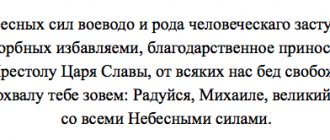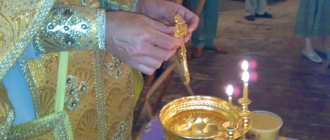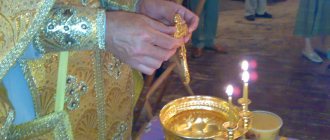Triumph of Orthodoxy
Creation of Cyrus Theophanes
Song 1
Irmos: The seas of the Black Deep, with damp feet ancient Israel walked, with the cruciform arm of Moses, he defeated the power of Amalek in the desert.
Chorus: Glory to Thee, our God, glory to Thee.
Today we cry out with joy to the faithful: how wonderful are your works, O Christ, and great is the power, who has made our like-mindedness and harmony!
Chorus: Glory to Thee, our God, glory to Thee.
Come let us celebrate the joyful day of God, now heaven and earth are rejoicing, and the angels are celebrating, and the gatherings of men are quite festive.
Chorus: Glory to Thee, our God, glory to Thee.
Having seen the great good deed, let us clasp our hands, the divergent hearts of Christ are united into unity, and we praise God who gave peace.
Glory: This day, victorious, was given to the Church, by God’s moving gesture and advice, to Michael and Theodora, who piously upheld the faith of our kings.
And now: The weapons of the wicked have disappeared from the presence of heresies, for Thy temple, Most Pure and Pure, in images adorned with all-blessing vision, now we rejoice with all-holiness.
Song 3
Irmos: Your Church rejoices in You, O Christ, calling: You are my strength, Lord, and refuge, and confirmation.
Chorus: Glory to Thee, our God, glory to Thee.
No one will raise an eyebrow at the wicked heretics today: for the power of God has kept Orthodoxy.
Chorus: Glory to Thee, our God, glory to Thee.
Let the clouds of prophecy sprinkle life-giving dew from Heaven to us today for the rise of faith.
Chorus: Glory to Thee, our God, glory to Thee.
With blessing the secret trumpets of Christ’s apostles, let them cry out above nature for the correction of honest images.
Glory: Let us sing to Christ, who showed us a pious, Christ-loving queen with a God-crowned branch.
And now: Your sacred village has reached the top, Most Pure One, now be illuminated by light-like grace, we pray.
Lord have mercy. (Thrice)
Sedalen, voice 1
Your divine image, forming the image, Christ, we clearly cry out the Nativity, the unspeakable miracles, the free crucifixion. They will drive away the demons with fear, and they will weep in slander, like they are partakers of these.
Glory: With the eyes of the prophets, the apostles, the holy martyrs, and all the saints with icons and sacred images, the spiritual Groom and the Bride are decorated with smart beauty, Mother of the Most High Sio n.
And now: To those who venerate Thy holy icon, and to those who venerate Thee, the true Mother, in accordance with the proclaiming, and faithfully worshiping Thee, Thou art the guardian, and the sovereign representation, averting all Something fierce is far away from these, like all that is mighty.
Song 4
Irmos: You are exalted, having seen the Church on the Cross, the righteous Sun, standing in its rank, worthy of those who cry: glory to your power, Lord.
Chorus: Glory to Thee, our God, glory to Thee.
By the influx of the Divine Comforter, sanctify your temple, and by the coming of this heretical charm of rejection, the Word of God is much merciful.
Chorus: Glory to Thee, our God, glory to Thee.
Having delivered the most needy of Thy wickedness, people, show piety kindled by zeal, and by faith they cry: Glory to Thy power, Lord.
Chorus: Glory to Thee, our God, glory to Thee.
With sacred images, images of Christ and the Mother of God, shining Divine village, we sacredly rejoice.
Glory: The Queen is adorned in both ways, desiring the true Kingdom of Christ, painting a most pure image and images of saints.
And now: Having given birth to the Divine Word, You have shown His divine sanctification, and we are renewing Your radiant temple.
Song 5
Irmos: You, Lord, my Light, have come into the world. Holy Light, turn those who sing of You through faith from the darkness of ignorance.
Chorus: Glory to Thee, our God, glory to Thee.
Grant, Lord, for Your Church to remain unshakable in the age of ages from the turmoil of heresies.
Chorus: Glory to Thee, our God, glory to Thee.
The light from above arose throughout the whole earth, giving joy and divine intercession to the faithful.
Chorus: Glory to Thee, our God, glory to Thee.
O One Good One, and Source of goodness, You exalt the horn of our blessed Emperor, who honors Your image.
Glory: The unstoppable light of piety has arisen for us, by the divinely inspired command of the faithful shepherds, and by the mania of the God-wise.
And now: Renew for us the ancient beauty, Most Pure Mother of God, and sanctify this Thy house with Thy grace.
Song 6
Irmos: I will devour Thee with a voice of praise, Lord, the Church cries out to Thee, having been cleansed from the blood of demons, for the sake of mercy the Blood flowed from Thy side.
Chorus: Glory to Thee, our God, glory to Thee.
The faithfully worshiped image of the Lord is painted and revered, and the Church again receives boldness, piously glorifying the Savior.
Chorus: Glory to Thee, our God, glory to Thee.
The Church of Christ is laid bare of lamentations and the darkness of heresies, and wears the robe of joy, and is covered with divine and luminous grace.
Glory: Receive the blessings of the ancient radiance of the Orthodox cathedral, Theodora, by the wave of the queen, and her son, the pious Michael the autocrat.
And now: Of old, Who commanded that there should be a tabernacle, as in the tabernacle of words, One Most Glorified One lives in You, glorifying Your temple, O Virgin, with miracles.
Lord have mercy. (Thrice) Glory, And now:
Kontakion, tone 2
The indescribable Word of the Father, from You, Mother of God, is described incarnate, and the defiled image is imagined in the ancient one, with the divine goodness of the mixture; but confessing salvation, in deed and word, we imagine this.
Ikos
This is a sacrament of vision, the prophets of old, divinely inspired, for our sake at the end of the ages who reached the foretelling, having received this radiance. The mind is Divine from Him from above, we know the One Lord God, in three Hypostases we worship, and He serving Him alone, having one faith, and having one baptism, having put on Christ We pray, but we confess salvation, in deed and word, we imagine this.
Song 7
Irmos: In the cave of Abrahamstia, the youths of the Persians, with love of piety rather than with flame, scorched, cried out: Blessed are you in the temple of Your glory, O Lord.
Chorus: Glory to Thee, our God, glory to Thee.
May the angelic army rejoice in the lordship of the Church and the Divine love, chanting with wisdom: blessed art thou in the temple of thy glory, Lord.
Chorus: Glory to Thee, our God, glory to Thee.
The Church of the firstborn, and the triumph rejoices, seeing now the Divine people, singing with one wisdom: Blessed art thou in the temple of Thy glory, Lord.
Glory: Having first delivered the dark heresies, through the mania of Theodora, the venerable queen, we sing: blessed art thou in the temple of Thy glory, O Lord.
And now: Thou hast ascended above the heights of the heavens, the All-Pure One, who was once the Mother of the All-Knowing; Rejoicingly we cry: blessed art Thou among women, O All-Immaculate Lady.
Song 8
Irmos: Daniel stretched out his hand, quenched the gaping lions in the den: he quenched the fiery power, girded with virtue, the zealous youths, crying out: bless all the works of the Lord.
Chorus: Glory to Thee, our God, glory to Thee.
Preserving the laws of the Church of the Fathers, we write images, and kiss the lips, and the heart, and the will of Christ, and His saints, calling: bless all the works of the Lord.
Chorus: Glory to Thee, our God, glory to Thee.
To the prototype of the image, we exalt honor and worship, we honor those who speak God with the teaching that follows, and we call to Christ by faith: bless all the works of the Lord the Lord.
Glory: Having illuminated your mind with the enlightenment of the Divine Spirit, honest queen, possessing the fruits of the God-wise, love the beauty of the Church of Christ, and beauty, blessing together with the faithful Jesus the God-man.
And now: With the rays of the wise light, your illuminated Divine house now overshadows everyone with the cloud of the Spirit, and sanctifies the faithful, in agreement with those who sing: bless all the works of the Lord, the Lord.
Song 9
Irmos: The uncut stone from the uncut mountain is for you, O Virgin, the cornerstone cut off, Christ, the aggregate of the dispersed nature. Thus, with joy, we magnify You, Mother of God.
Chorus: Glory to Thee, our God, glory to Thee.
Having adorned the holy Church with images of the Holy Scriptures, we all cry out to God with reverence: We magnify You, Trisagion.
Chorus: Glory to Thee, our God, glory to Thee.
Having acquired honor and glory, the Church, Your Cross and honorable icons, and images of saints, with joy, O Lord, magnify You with joy.
Glory: Illuminate our people with Your Divine glory, Generous One, and with the hosts of Angels, and all the weapons of this fence, rebuking them with the ferocity of the tongues, O Lord.
And now: Eve’s foremother will be condemned, O Mother of God, for You, the Lord of all, unspeakably, the Pure One, gave birth to you.
We still kiss his likeness on icons.
Personal Celebration
If we talk about the spiritual meaning of the holiday for us, ordinary believers, for our spiritual life, then, of course, the Triumph of Orthodoxy can be understood somewhat more broadly, not only in the dogmatic-theological sense. When a person embarks on the path of fasting, trying to pray more and ascetically limit himself in some way, then this is where the triumph of faith begins.
Of course, we can simply declare our Orthodox faith in words, but constant life in Christ, the zeal with which many begin Lent (and which, unfortunately, not everyone has enough for the entire Lent) - this can be considered our kind, a personal Triumph of Orthodoxy.
This is already a certain experience of a person, and not just a memory of events and dogmatic disputes in the Church almost a thousand years ago.
In modern realities, the Triumph of Orthodoxy must also be understood as a kind of personal conclusion of the beginning of Lent, when a believer really tries to live as a Christian should live, to the maximum extent possible for himself. First of all, a person prays more, goes to services, to the penitential canon of St. Andrew of Crete... And all these efforts ultimately lead to the triumph of personal life in Christ. It is on this, it seems to me, that it is worth emphasizing today, and not on dogmatic definitions, which undoubtedly affirm this holiday.
The iconography of the Triumph of Orthodoxy developed by the 14th - 15th centuries. The earliest image that has come down to us, symbolically conveying the idea of the Triumph of Orthodoxy and the veneration of icons, is a Byzantine icon of the 14th century, stored in London, in the British Museum
What did Saint Theodora pray for?
In the middle of the 9th century, the period of iconoclasm ended. A terrible debate lasted for a century and a half about whether it was possible to depict Christ, the Mother of God, and saints and pray in front of these images. Disputes escalated into brutal persecution and murder of icon worshipers. This dramatic period of church history ended with an event that we call the Triumph of Orthodoxy and remember on the first Sunday of Great Lent. The icon talks about him.
In the center of the iconographic composition, the largest icon of the Mother of God “Hodegetria” (“Guide”) is depicted. The icon stands on the Throne, supported by two angels in red court robes.
“In Byzantium, the icon of the Mother of God “Hodegetria” was especially revered,” says Yuri Zemtsov, icon painter, teacher at the Department of Theology of Tula State University, candidate of philosophical sciences
. — She was considered the patroness of the Byzantine state. She was given honors, and military victories were associated with the intercession of the Most Holy Theotokos. If during the period of iconoclasm, when speaking about an icon, they meant primarily the icon of Christ, then by the 14th century, when the iconography of the Triumph of Orthodoxy was taking shape, the icon of the Mother of God became the main icon of Byzantium, and it was she who was remembered first of all. The throne on which the icon of the Mother of God is placed is a sign that the icon is a liturgical image and is included in the Liturgy. For example, the Seventh Ecumenical Council (787) decided to venerate the icon along with the Cross and the Gospel, and they are placed on the Throne.”
The placement of the icon on the Throne recalls the prayer service before this icon performed by Patriarch Methodius of Constantinople, Empress Theodora, her three-year-old son Michael and the entire Orthodox people on March 11 (that year it was the first Sunday of Lent) 843 in the Church of Hagia Sophia. After the prayer service, a religious procession was held throughout Constantinople, and the believers returned the preserved icons to their places in the churches. According to legend, during the prayer service, Theodora thanked God for the forgiveness of her husband, Emperor Theophilus, formerly a fierce iconoclast. In the twelfth year of his reign he became very ill. Once Theodora heard the cry of the emperor: “Woe to me, the unfortunate one: I am being beaten for the sake of holy icons!” Despite the ban, the empress secretly kept several icons in her bedroom. Hearing her husband’s screams, she prayerfully placed the image of the Virgin Mary on the sick man. The emperor kissed the holy image, and he felt better. He died soon after.
After the death of her husband, Theodora restored Saint Methodius, overthrown by Theophilus, to the Patriarchal throne of Constantinople, and convened a Council that anathematized the iconoclasts. Participants in the Council listed the emperor as heretics, but his name miraculously disappeared from the list. For this, Theodora thanked God, returning the icons to their places.
Participants and eyewitnesses
The icon of the Triumph of Orthodoxy is divided into two rows. At the top left of the icon of the Mother of God is the righteous Empress Theodora with her son Michael. Tsarevich Michael is present on the icon, despite the fact that he was later nicknamed the Drunkard for his dissolute life. The icon depicts him as a participant in the historical event that formed the basis of the plot.
To the right of the Throne are St. Methodius and St. Theodore the Studite, abbot of the Studite Monastery, author of numerous works in defense of icon veneration. Even when imprisoned by the iconoclast emperor Leo the Armenian, he continued to defend icon veneration in his letters.
In the bottom row in the center are depicted Saint Theophan the Sigrian Confessor (a participant in the Seventh Ecumenical Council, under Leo the Armenian, who resumed iconoclasm, he spent several years in captivity and died in exile) and Stephen the New (a monk from Mount Auxentia, was the mentor of all Constantinople monasticism, advised the monks not to succumb to the provocation of the iconoclasts, and for the weak to hide where there is no persecution), holding the icon of Christ. To their right is Theophylact the Confessor, Bishop of Nicomedia, he participated in the negotiations between Leo the Armenian and the holy Patriarch Tarasius, who tried to convince the emperor not to renew the iconoclastic heresy after the Seventh Ecumenical Council. Next are two brothers, Theodore and Feofan the Inscribed. The brothers - defenders of icons received such a strange nickname because, by order of Emperor Theophilus, offensive verses were burned on their faces with hot needles.
To the left of the Throne is the martyr Theodosia holding the icon of Christ Emmanuel in her hands. It was she who prevented the soldier from throwing off the copper image of the Savior, which had hung on the gates of Constantinople for more than 400 years. For this, Theodosia was killed. Researchers were unable to identify the figures of monks between Feodosia and Feofan due to severely damaged inscriptions.
“By placing images in upper case, they often want to emphasize their significance, but in this case this method of interpretation is not applicable,” comments Yuri Zemtsov. — In the top row we see either direct participants or close contemporaries of the events of 843. In the lower case - saints related to the protection of icons and icon veneration, who lived earlier, in the 8th century. Without their exploits and labors, the Triumph of Orthodoxy would not have taken place; they act as the foundation, as the basis of this iconography.”
Source: https://www.pravmir.ru. Icon of icon worshipers. Author: Irina Redko
